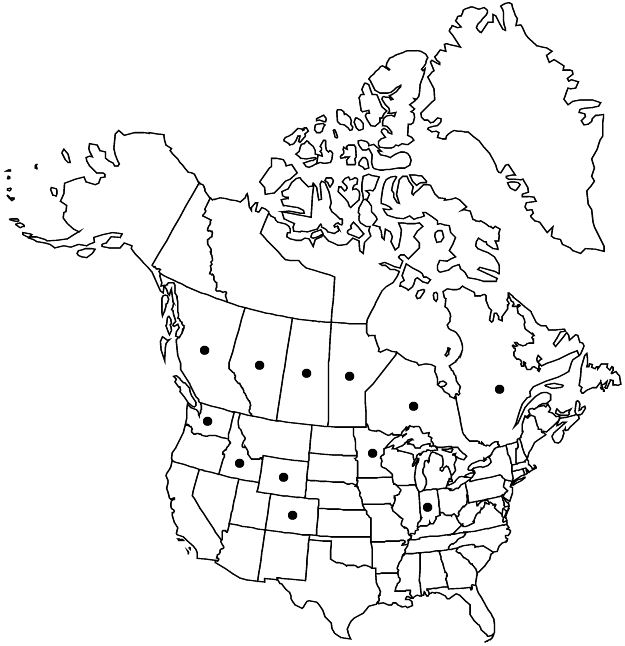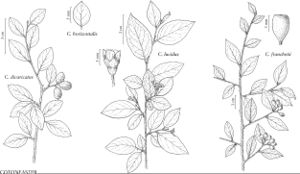Difference between revisions of "Cotoneaster lucidus"
Linnaea 27: 541. 1854.
FNA>Volume Importer |
FNA>Volume Importer |
(No difference)
| |
Revision as of 23:13, 16 December 2019
Shrubs, 1.5–2.5 m. Stems erect, arching, or spreading; branches spiraled or distichous, dense, greenish gray to maroon, not lenticellate, initially strigose. Leaves deciduous; petiole 4–8 mm, strigose; blade elliptic or ovate, sometimes obovate, 28–50(–65) x 17–32(–40) mm, chartaceous, base cuneate or rounded, margins flat, not revolute, veins 3–5, sunken, apex short-acuminate or acute, abaxial surfaces green, sparsely pilose-strigose, adaxial dark green, intensely shiny, not glaucous, flat or scarcely bulging between lateral veins, slightly rugose, initially sparsely strigose; fall leaves intense dark red, yellow, or orange. Inflorescences on fertile shoots 25–50 mm with 4 or 5 leaves, 2–6(–15)-flowered, lax. Pedicels 5–12 mm, sparsely pilose. Flowers 5.5–8 mm, largely open; hypanthium cupulate, base sparsely pilose, glabrescent; sepals: margins villous, apex acute or acuminate, surfaces glabrous; petals erect, pinkish white, sometimes green-tinged, base dark pink or reddish; stamens 18–20, filaments pink, base dark pink, anthers white; styles 2 or 3. Pomes black, broadly obovoid to obovoid, rarely ellipsoid or globose, (8–)9.5–12.1 x (7.5–)8.7–11.8 mm, shiny, glaucous, sparsely pilose; sepals flat, margins villous, sparsely pilose; navel open; style remnants 2/3 from base. Pyrenes 2 or 3. 2n = 68 (Germany).
Phenology: Flowering Mar–Jul (sometimes reflowering in Sep); fruiting Jul–Oct.
Habitat: Deciduous or coniferous forests, ravines, lakeshores, forested dunes, thickets, edges
Elevation: 0–2300 m
Distribution

Alta., B.C., Man., Ont., Que., Sask., Colo., Idaho, Ind., Minn., Wash., Wyo., Asia (Mongolia, Siberian Russia), introduced also in Europe.
Discussion
Leaf glossiness is often retained on herbarium specimens and is visible with strong lighting and magnification.
Plants of Cotoneaster acutifolius of China and Mongolia are seldom seen in cultivation. Reports of it naturalized in North America are here referred to the commonly cultivated C. lucidus, which tolerates continental winters. No specimens have been seen to support reports of the latter from Montana and Oregon. Some reports of C. melanocarpus from Alberta and Manitoba (H. J. Scoggan 1978–1979, part 3) are here referred to C. lucidus.
Selected References
None.
